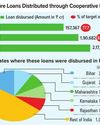
However, many ARDBs still rely on manual processes, hindering efficiency and limiting their ability to serve their members effectively. Traditionally, ARDBs in India have operated with manual processes, including paperbased record-keeping, loan processing, and customer interactions. This manual approach is time-consuming, prone to errors, and lacks scalability. It also restricts access to modern banking services for rural communities, limiting financial inclusion and hindering agricultural and rural development.
BACKGROUND
Agriculture and Rural Development Banks (ARDBs) play a crucial role in India’s economic landscape, particularly in rural areas. Earlier they were known as Land Development Banks (LDBs). The first Land Development Bank (LDB) was started in Jhang, Punjab, in 1920. However, significant progress occurred when the Central Land Mortgage Bank was established in Chennai in 1929. LDBs were initially known as co-operative land mortgage banks. Their primary purpose was to provide long-term loans to farmers against the conveyance of land as security.
LDBs granted loans for land development, agricultural projects, and business ventures. They focused on financing infrastructure development and promoting rural economic At present, there are 16 SCARDBs of which only 13 are fully functional with a network of 1806 PCARDBs/branches. Organizational structure of ARDBs as it emerged over the years is not uniform all over the country. Thes structure is federal in 7 States, unitary in 7 states and mixed in 2 states. These banks provide term loans for agriculture along with production credit. They have a total membership of nearly 10 million rural households.
NAFCARD (National Cooperative agriculture & Rural Development Banks Federation) was established with twin objectives:
To promote interests of all its members and assist them in attaining organizational and business goals.
This story is from the June 2024 edition of Banking Frontiers.
Start your 7-day Magzter GOLD free trial to access thousands of curated premium stories, and 9,000+ magazines and newspapers.
Already a subscriber ? Sign In
This story is from the June 2024 edition of Banking Frontiers.
Start your 7-day Magzter GOLD free trial to access thousands of curated premium stories, and 9,000+ magazines and newspapers.
Already a subscriber? Sign In

Excelling by partnering with Fenergo, SBS, Aurai, Avanade & others
The Netherlands-based NIBC Bank defines itself as an entrepreneurial asset financier for companies and individuals, having funded private housing ventures, rental property, commercial real estate, infrastructure and cars and claims it makes a difference for its clients through long-term relationships based on knowledge and expertise.

Drive by Connectivity, Automation & Analytics: SEB
Skandinaviska Enskilda Banken, or SEB, promotes digitization as much as it operates as an established bank:

Afterhour Passions
Professional success is often shaped by what a person does afterhours. Let us look at a few such people and what hobbies recharge their body, mind and spirit:

A colossal rise in agri credit
A study by 3 academics on the impact of bank credit for agricultural sector reveals very encouraging trend:

The Future of Cybersecurity: Balancing AI & Human Expertise
There is no denying the fact that the continued evolution in AI will redraw the landscape of cybersecurity. In this respect, the future of digital defences rest on how effectively AI capabilities are balanced with human expertise.

REINFORCING BRAND COOPERATIVE
Banking Frontiers organized its annual Frontiers in Cooperative Banking Awards and Conference in Lucknow in October where stalwarts from the sector shared insights into progress achieved and gave guidance on the road ahead.

Magma HDI & Mahindra Finance collaborate to expand insurance access nationwide
Mahindra Finance, a leading player in India's non-banking financial services sector, has forged a strategic partnership with Magma HDI General Insurance Company to deliver customized general insurance solutions to its extensive customer base.

AI for underwriting, personalization, claims & more
Sunil Jain, Chief Digital Technology Officer, Pramerica Life Insurance:

IoT & Chatbots - a rich data trove
Aditya Mall, Appointed Actuary at Future Generali India Life Insurance reveals new opportunities in insurance and the enablers:

Marching hand-in-hand: Innovation & Automation
In the January 2024 issue of Banking Frontiers, Gyanendra Singh, CTO of Aviva India, had shared about how the company excels at RPA through governancebased implementation and pragmatic vendor selection. He shares more initiatives since then:
